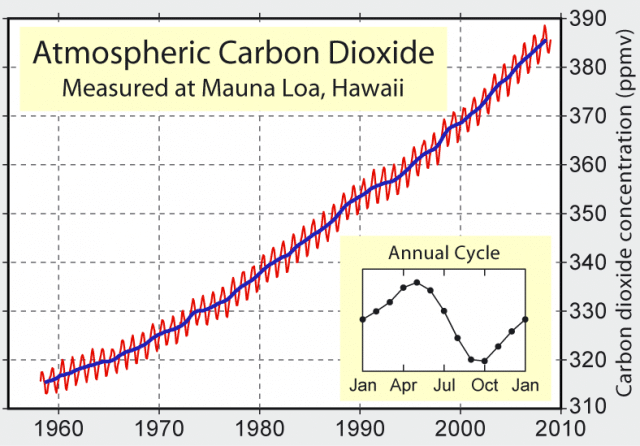There’s a saying that trouble comes in threes. Earlier this week, the International Energy Administration announced that emissions reached a record high last year, increasing by 1 Gt worldwide. At the Bonn climate talks, experts have warned that the window to curb a global temperature rise of more than 2 degrees is swiftly drawing to a close.
To cap it off, NOAA released the news that carbon dioxide levels have reached a new milestone this spring, tipping the scales over 400 ppm, a concentration the world hasn’t seen in the last 800,000 years.
Scientists are seeing these high concentrations at their northernmost stations in the Arctic. Remote sites measure the gas in Alaska, Canada, Iceland, Finland, Norway, and also an island in the North Pacific, Mauna Loa, which has been recording ambient CO2 concentrations since 1959 (and produced the now-famous Keeling curve).
The global average is still around 395 ppm, but the Arctic is seen as an important indicator for global conditions to come, since it is an ecosystem that is much more sensitive to changing conditions.
“The northern sites in our monitoring network tell us what is coming soon to the globe as a whole,” said Pieter Tans, an atmospheric scientist with NOAA’s Earth System Research Laboratory (ESRL) in Boulder, Colo. “We will likely see global average CO2 concentrations reach 400 ppm about 2016.”
Before the industrial revolution, concentrations were closer to 280 ppm and have been increasing at an accelerating pace ever since. Back in the 1960s, carbon dioxide was climbing the scales at about 0.7 ppm per year, however for the last decade the rate has been closer to 2 ppm per year.
While carbon dioxide is one of the most significant greenhouse gases, most people know by now that it’s not the only one. More powerful greenhouse gases like methane, nitrous oxides, and CFCs absorb more heat than carbon dioxide. If you convert the strength of these gases to the same scale as CO2, then by that measure the concentrations are calculated to be even higher than 400 ppm.
The reason the Arctic measurements are notable is because it’s an area that is, for the most part, devoid of human development and industry. For example, measuring stations near urban centers have spiked over 400 ppm for years because of the proximity to excess activity. But the Arctic doesn’t have scores of cars and factories nearby and shows that the effect of the worldwide burning of fossil fuels is reaching remote areas.
Another characteristic of the Arctic is that vegetation is scarce, meaning there’s no foliage to soak up atmospheric carbon. Normally every year during the summer, CO2 levels depress slightly because the trees of the Northern Hemisphere (where most of the world’s forests are located) start to green again. This is also why CO2 levels may seem lower at the equator, where most of the rainforests are.
Despite minor local variations, global concentrations are steadily rising.
With news like this, it’s important to not succumb to bad journalistic habits, such as quoting representatives from CEI and the Cato Institute, who are still trotting out the narrative that temperatures have leveled since 1998.
Subscribe to our newsletter
Stay up to date with DeSmog news and alerts







